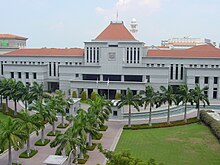Penal Code (Singapore)
| Penal Code | |
|---|---|

|
|
| An Act to consolidate the law relating to criminal offences. | |
| Citation | Ordinance No. 4 of 1871 (Straits Settlements); now Cap. 224, 2008 Rev. Ed. |
| Enacted by | Governor of the Straits Settlements with the advice and consent of the Legislative Council |
| Date enacted | 1871 |
| Date commenced | 16 September 1872 |
| Amendments | |
| Penal Code (Amendment) Act 2007 (No. 51 of 2007) | |
The Penal Code of Singapore sets out general principles of the criminal law of Singapore, as well as the elements and penalties of common criminal offences such as homicide, theft and cheating. The Penal Code does not exhaustively define all the criminal offences applicable in Singapore – a large number of these are created by other statutes such as the Arms Offences Act,Kidnapping Act,Misuse of Drugs Act and Vandalism Act.
For most of the 19th century the criminal law which applied in the Straits Settlements (comprising Prince of Wales' Island (Penang), Singapore and Malacca) was that of the United Kingdom, insofar as local circumstances permitted. There was little doubt that at the time English common law crimes were recognized in these territories. However, due to problems such as doubts as to the applicability of Indian Acts, in 1871 the Straits Settlements Penal Code 1871 was enacted. It came into operation on 16 September 1872. The Code was practically a re-enactment of the Indian Penal Code.
Over the years, the Penal Code has been amended several times. In 1973 punishments for certain offences were enhanced, and by the Penal Code (Amendment) Act 1984, which came into effect on 31 August 1984, mandatory minimum penalties were introduced for certain offences.
The Penal Code has over 500 sections, and is divided into the following 24 chapters:
The Penal Code defines the elements of each offence and prescribes the maximum, and occasionally also the minimum, penalties for it. The basic form of an offence (commonly referred to as the 'simple offence' or, using Latin terminology, as the 'offence simpliciter') has the lowest penalties. More serious forms of the offence are defined as separate offences and attract stiffer penalties.
For instance, theft is defined in section 378 of the Code, and section 379 makes simple theft (or theft simpliciter) an offence punishable with imprisonment of up to three years or with fine or both. Section 379A punishes the theft of a motor vehicle or any component part of a motor vehicle with imprisonment of not less than one year and not more than seven years and a fine. Sections 380 and 381 respectively make it offences to commit theft in any building, tent or vessel which is used as a human dwelling or for the custody of property; and, while being a clerk or servant, or being employed in the capacity of a clerk or servant, to commit theft of any property in the possession of one's master or employer. In both cases the penalty is imprisonment of up to seven years and a fine. The most serious theft offence is that of committing theft, having made preparation for causing death or hurt or restraint, or fear of death or of hurt or of restraint, to any person in order to commit the theft, or in order to effect an escape after committing the theft, or in order to retain property taken by the theft. The maximum penalty is imprisonment for up to ten years and caning with not less than three strokes.
...
Wikipedia
